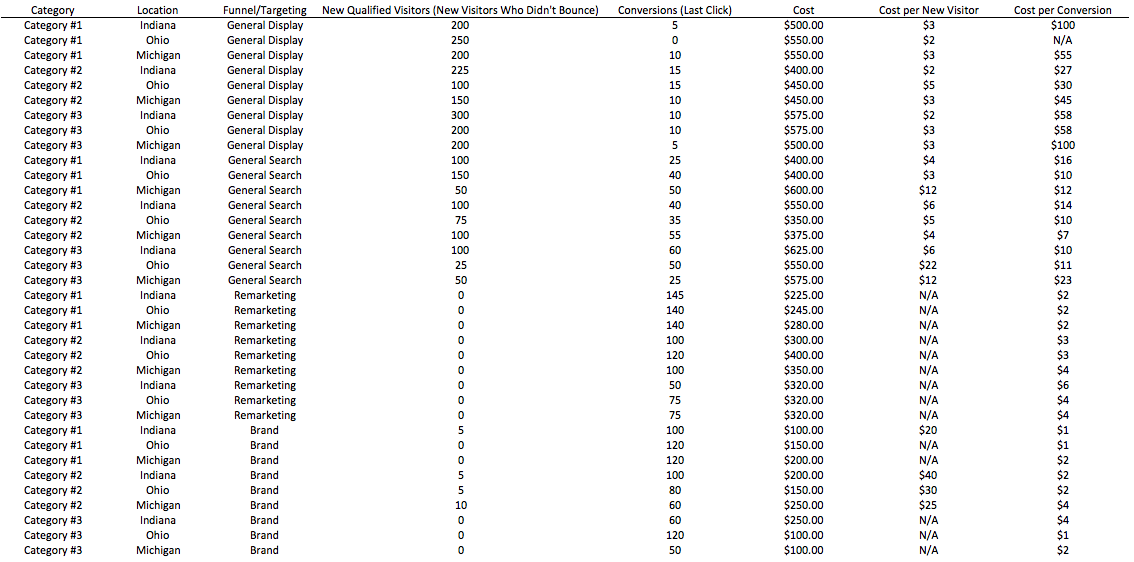Does a conversation like the one below sound familiar?
Agency: What goals should we be targeting for this account?
Client: Um, we typically shoot for a $100 CPL, but what do you think we should be targeting?
So much goes into determining goals – and by no means should the goal stay constant across an entire account (in most cases). What are the top questions that should be asked when talking with a client about goals? Here are a few that can help with the conversation:
- Do you have final step data on leads that we can look at?
- Are different types of leads worth more than others?
- Can we establish funnel-level of each of our campaigns?
Answering these questions is crucial, as typically having the same CPL goal across a lead gen account is the wrong route to take. Through this post, we’ll review a few examples as to when a CPL goal would differ in one area of an account from another and why, and then pull a different situation to tie everything together.
Situation #1: A client has different priced categories that also differ in price per location:

Pretty simple scenario here. The more money something costs, the higher of a CPL we are willing to take. It wouldn’t make sense to be looking for the same CPL on Category #3 in Michigan as Category #1 in Indiana. Category #3 in Michigan is twice the price. A real-life example would be for an EDU client with different program offerings where one program costs a lot more than another.
Situation #2: A client sees different final step rates for one location & category compared to another:

In the scenario above you can see different rates from a lead (conversion) to the final step (subscription). We’re adjusting the CPL Goals accordingly as seen in the screenshot. An example that could be used here would be magazine subscribers where the conversion is a Free Trial and different rates per category of magazine and location of user are found per subscribers off of those users using the Free Trial benefit.
Situation #3: A client has different funnel stages working in their account (ie: General Display, General Search, Remarketing, Brand terms, etc).

Above is a simplistic way of looking at funnels. General Display and General Search see a lot of New Visitors at cheap rates. Remarketing and Brand see many conversions come through at cheap rates. These are completely different types of advertising so we not only want to have different numbers for our goals but we want to be looking at completely different metrics. Check out your rates in terms of number of new visitors who didn’t bounce the first time in terms of how often those users come back and convert. Make sure you know the right ways to tell if new visitors are quality visitors coming to your site (is it bounce rates?, is it pages visited? should they be hitting a certain page?). Be sure to send users in the research stage to more research-oriented pages and not just PPC-specific pages with lead forms. These are all items you need to be thinking about.
In this scenario is there a perfect answer? No. With all of the attribution models available, I think this is one thing we’re missing. Goals need to be different based on type of advertising. An attribution model hopefully helps to tie everything together but in almost every model there are flaws. The goal of top of funnel advertising is to get users interested in your brand/product. Treat it that way. The goal of bottom of the funnel advertising is to get the user to the purchasing stage quickly. Treat it that way. It’s tough to treat these two different types of advertising alike with one attribution model. (Obviously – not the answer everyone wants to hear, but it’s the truth).
As seen above, many different things can be looked at when setting goals. So let’s review a larger situation where the focus is top of funnel advertising, while also considering the other two situations as well. This extreme example is meant to shine a light on how in-depth you can get with goal setting. Not necessarily showing how you should set your goals but how you can set your goals with top of funnel advertising.

Above shows conversion rates from new visitors, strictly holding to the amount of the new visitors per category likely to eventually convert. It adds in subscriptions rates, price of subscriptions, average monthly tenure (meaning how long a user typically is subscribed per each category), and considers the likely amount of money it’ll take to get users to the conversion stage from the new visitor stage. From there we figure out how much we can spend per new visitor in order to hit ROAS Goals with spend from both top and bottom of funnel while having completely different metric goals per funnel level.
Is it easy to navigate through data to find eventual conversions per new visitor or decide on a bottom of funnel CPL number? No. But this is the type of information you want to dig down as deep as possible to in order to set different goals per funnel and different goals per different categories of your business.
Conclusion
The final example given would be hard to precisely figure out (though it is getting to be a greater possibility with different platforms becoming available). In the end, the point of this article is to assure you are giving deeper thought to what your goals should be based on items such as category, location, and funnel and how they perform differently. Think through ways to make sense of the data to land at goals rather than thinking through ways that will be easiest to report on. Because if you focus only on areas easiest to report on you may end up pulling away from some of your top performing advertising efforts because of lack of creativity in how to judge success.



